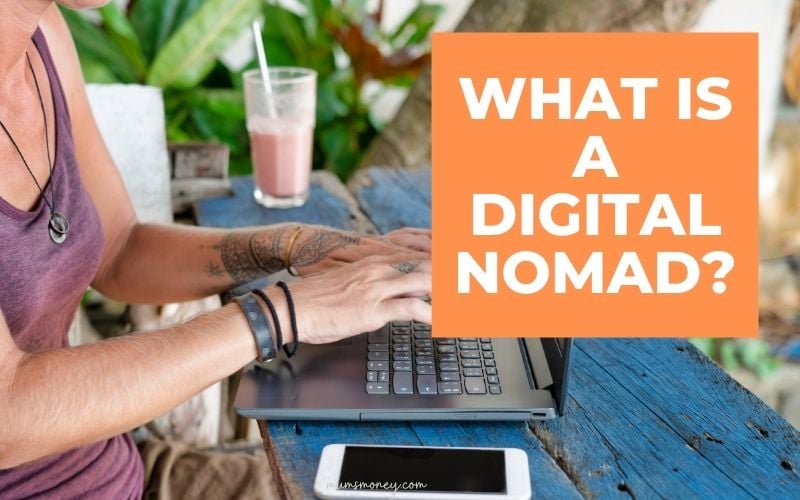You may have heard about a new kind of traveler called a “digital nomad.”
It sounds like some kind of futuristic, sci-fi term, but it’s actually a very real and rapidly growing phenomenon. So what is a digital nomad?
A digital nomad is someone who works remotely and uses technology to stay connected with their work. This could include using a laptop or tablet to work on projects from anywhere in the world.
Digital nomads are “location independent,” meaning that their job does not require them to live in one specific location all year long.

Becoming a digital nomad can be the journey of a lifetime for some people. It offers the opportunity to see the world and work from anywhere there’s an internet connection.
But it’s not all beaches and cocktails – there are a few things you need to know before becoming a digital nomad yourself.
Read on to learn more about this new lifestyle and whether or not it’s right for you.
Table of Contents
What Is a Digital Nomad?
A digital nomad is more than a specific type of job, location, or lifestyle. It’s a combination of these factors that make up the life of someone who works from anywhere in the world and isn’t tied down to one specific location.
People choose this lifestyle because it helps them to fulfill more of their personal life goals and focus less on the traditional workforce lifestyle.
It can be a great way to see the world, meet new people, and learn new things.
But it’s not for everyone – there are some definite pros and cons to being a digital nomad that you need to consider before making the leap.
Pros of Being a Digital Nomad
Location Independence: One of the biggest pros of being a digital nomad is the fact that you’re location independent. This means you can work from anywhere in the world as long as you have an internet connection.
Saving Money: When you’re not tied down to one specific location, you can save a lot of money on things like rent and utilities.
Flexible Work Schedule: Another pro of the digital nomad lifestyle is that you have more control over your work schedule.
You can choose to work during the day or night, depending on what works best for you.
Cons of Being a Digital Nomad
Lack Of Stability: One downside to the digital nomad lifestyle is that it can be quite unstable. Your work could disappear at any moment, which means you need to always have a backup plan in place.
Isolation: Since digital nomads often work from home or coffee shops, they may feel isolated from other people in their community.
And if you’re traveling abroad, you may seriously miss friends and family. It’s important to make sure you have a support system that can help if this happens.
Unpredictability: The final con of the digital nomad lifestyle is its unpredictability. You never quite know what’s going to happen from one day to the next, which can be stressful for some people.
So Is It Right For Me?
The answer to this question depends on a lot of different factors, including your personal goals and lifestyle preferences.
If you’re someone who wants more freedom and flexibility in your life, then the digital nomad lifestyle could be a great option for you.
But if you’re looking for more stability and predictability in your work life, then this may not be the right choice for you. Talk to other digital nomads or do some research online to see if this lifestyle is a good fit for you.
What Do Digital Nomads Actually Do?
A typical day for a digital nomad can include anything from working on a website to writing blog posts, answering emails, and making sales calls.
They may be doing this at a cafe near the beach, a co-working space in a major city, or in their rental unit.

Some digital nomads work for themselves as freelancers or consultants; others have jobs that allow them to travel around the world while still being connected with their company back home via email and phone calls.
It all depends on what type of work they’re doing and what their personal goals are.
Outside of their work lives, these individuals usually change locations every few months or so.
This greatly ranges from traveling to a new country every month to simply moving to a different part of the city they’re in.
Some remote workers stay in foreign countries for even longer, and there is an emergence of digital nomad visas that allow people to do this.
Time is almost always reserved for exploring the local cultural and natural sites.
Digital nomads maintain a reasonable budget as well as some free time for this exploration since it’s one of the main benefits of this lifestyle.
Where Do Digital Nomads Live?
Digital nomads live all over the world! But they’re especially concentrated in popular destinations like Thailand, Bali, and Vietnam.
Other locations in Central America, South America, and Europe have also developed popular ex-pat communities.
These countries have become increasingly more accessible for remote workers and are home to many coworking spaces that cater specifically to digital nomad communities.
You can find ex-pat groups on Facebook, visit forums in areas you’re curious about, or even consult a travel agent who specializes in this type of lifestyle.
They live in hostels, sublets, short-lease apartments, and Airbnbs.
They often frequent coffee shops, co-working spaces, and restaurants that have free or cheap Wi-Fi. They often look for spaces with reasonable costs of living that are equal to or less than the cost of their hometown.
How Much Money Do You Need to Be a Digital Nomad?

Most digital nomads don’t need a lot of money to get started. All you really need is a laptop and an internet connection!
However, if you want to travel the world while working, your expenses will obviously be a bit higher than if you stayed put in one location.
Here are some of the major expenses you will encounter as a digital nomad:
Travel Expenses: This will vary depending on your chosen destinations and how frequently you move around. You can expect to pay for plane tickets, bus fares, train tickets, taxis, and hotel stays.
Living Expenses: If you’re constantly on the go, your living expenses will be higher than if you have a permanent residence somewhere. However, many digital nomads stay in inexpensive areas that allow them to save money while they travel.
Work Expenses: Some digital nomads need to pay for co-working memberships, fast internet connections, and other work-related items. However, the vast majority of remote workers can get by without these expenses.
Emergency Savings: Even the most seasoned digital nomads need to save up for emergencies. This will vary depending on your savings goals, but it’s a good idea to have at least three months’ worth of living expenses set aside in case something happens while you’re abroad.
On average, you will want to have at least $1500 to $2500 a month for a comfortable life as you work remotely, assuming you are living in countries with a lower cost of living than the United States.
Do Digital Nomads Pay Tax?

United States citizens and permanent residents who work remotely for a foreign company are still responsible for paying income tax to the Internal Revenue Service (IRS).
The rules for taxation can be quite complex, and it’s best to speak with an accountant or other financial professional if you’re unsure about your specific situation.
Generally speaking, digital nomads don’t have to worry about paying tax to the countries they visit.
They only have to pay taxes on the income they earn in their home country if that is where their company is based or where they are a citizen/permanent resident.
What Jobs Do Digital Nomads Have?
The jobs that digital nomads have are as diverse as the people who pursue this lifestyle.
Some work in tech, some are writers, some are entrepreneurs, and others still work traditional jobs that are converted to a remote format.
The important thing is that these workers can do their jobs from anywhere with an internet connection.
This flexibility allows them to take on a number of different types of work. A few examples include:
- Programmers and web developers
- Social media managers
- Virtual assistants (VA)
- Graphic designers and illustrators
- Writers, editors, and content creators
- Customer service representatives
- Business Owners
- Online teachers
- YouTube creators and bloggers
These jobs all have one thing in common: they can be done from anywhere in the world, and many of them have flexible hours as well.
In order to decide what job is best for you, it’s important to consider your skills, interests, and travel goals.
Brainstorm on a piece of paper or in a Google Doc about all the things you are good at and enjoy doing.
Then, consider how those skills can be turned into a job that allows you to travel the world while working remotely!
How Do You Start a Nomadic Lifestyle?

The great thing about the digital nomad lifestyle is that it can be started gradually. You don’t have to quit your job and sell all your belongings overnight!
Here are a few steps you can take to get started:
Check if Your Job Allows Remote Work: The first step is to see if your current job allows for remote work. Many companies are beginning to offer this option as more and more people are asking for it.
If your job doesn’t allow remote work, you can still pursue a nomadic lifestyle by finding a freelance or contract position that allows you to work from anywhere.
Save Up: One of the main hurdles for aspiring digital nomads is saving up enough money to cover their expenses.
This varies depending on your budget, but it’s a good idea to have at least three months of living expenses saved up before you make the jump.
Get Your Travel Gear Ready: Once you have your finances in order, it’s time to start packing! Make sure you have all the necessary gear for working remotely, such as a laptop, phone charger, and headphones.
Choose Your Destinations: Of course, the most exciting part is choosing where to go! You can start with a short-term trip and work your way up from there.
Or, you could jump right into long-term travel by planning out an entire year’s worth of destinations in advance.
Hit the Road: Once everything is ready, it’s time to hit the road! Enjoy your new nomadic lifestyle and make memories that will last a lifetime.
Final Thoughts
The digital nomad phenomenon is growing rapidly, and there are more and more people choosing to work remotely.
But it’s not for everyone. So ask yourself: am I ready to change my life and start living on my own terms? If so, then what are you waiting for?
Research your options. Get creative about how to make money from home or abroad.
And most importantly of all – have fun! This lifestyle choice is about adding happiness and fulfillment to your life.
Related:
- 16 Free Work From Home Online Courses to Jumpstart your Income
- 30 Genuine Ways to Make $100 a Day Online + Offline
- What is Geoarbitrage? What You Need to Know
